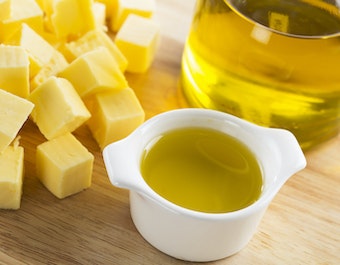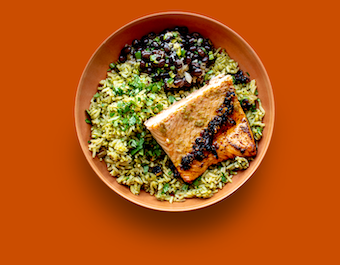There are some health rules that just seem to stick and persist year after year, decade after decade, even when nutritionists have updated their ideals. Just as the field of nutrition changes and evolves, so should the rules of thumb you use to guide your dietary choices. Before you begrudgingly reach for that eighth glass of H2O, read this:
Old-School Rule: You must drink eight glasses of water a day.
New Thinking: There’s nothing magical about the number eight. “You actually might need less or more — everyone’s hydration needs are unique,” says Sara Haas, RDN, LDN, a Chicago-based registered dietitian nutritionist and national spokeperson for the Academy of Nutrition and Dietetics. Are you pregnant or nursing? An avid athlete? Live in a hot climate? Those are some of the factors that could mean more reason to drink up. Another reason that you might not need to guzzle exactly 64 ounces of agua every day: You also get water from the foods you eat. “That means you can reach your hydration goals by not just drinking, but by eating, too,” she says.
Soups and smoothies aren’t the only way to up your hydration game, either. Haas recommends watermelon, celery, cucumbers, cauliflower, tomatoes, and spinach to help you stay hydrated. But how will you know if you’re hydrated enough? A quick peek at the bowl after using the bathroom will do the trick, she says: If your urine is colorless or light yellow, that’s a good indicator your body is well hydrated.
Old-School Rule: Breakfast is the most important meal of the day.
New Thinking: Not everyone benefits from a well-rounded morning meal, says NYC-based nutritionist Jillian Tuchman, MS, RD. In fact, some people who eat a substantial meal in the morning may find that their appetite stays revved up all day, she says. “The best rule is to figure out what works best for your body,” she says. If you can rise and shine without wanting to dine, that’s fine.
The research around eating or skipping breakfast isn’t clear-cut, either: Some experts argue that skipping the morning meal could leave you ravenous — and prone to overeating — later in the day. Yet another study, which tracked the eating habits of obese men and women for four months, found that those who ate breakfast didn’t lose any more weight than those who didn’t. And a systematic review of 15 studies found that, among adults, the notion that skipping breakfast leads to weight gain is inconsistent, at best. Bottom line: Find what works best for your body. If you have more energy if you eat breakfast, go for it. But if an early nosh doesn’t sit well with you, you may want to skip it.
Old-School Rule: Frozen foods lack nutrition.
New Thinking: Fresh is often still best, but frozen fruits and veggies aren’t the nutrient-depleted sodium bombs you might assume. “From vegetables to fish to even frozen meals, today’s freezer aisle has gotten a serious nutrition upgrade,” says Haas. She points to more brands offering frozen “bowls”— packed with fiber-rich grains and vegetables — along with entrees like butternut squash mac and cheese and cauliflower-crust frozen pizza, as well as an uptick in mainstream vegetarian and vegan options.
And having frozen veggies and fruits on hand may help you skip the takeout and work more produce into your own cooking, she says. Current government guidelines give a thumbs up to fresh, frozen, canned, or dehydrated produce. And when researchers at the University of California, Davis, compared the vitamin content in eight different fruits and veggies they found that “the vitamin content of the frozen commodities was comparable to and occasionally higher than that of their fresh counterparts.”
Old-School Rule: Swap sugar with artificial sweeteners.
New Thinking: Watch out for these sneaky substitutes. Artificial sweeteners may be calorie-free, but that doesn’t mean they’re a good weight-loss strategy. “A lot of people think artificial sweeteners are an easy fix,” says Tuchman. “But what we know now is that when your body tastes something sweet, your mind thinks it’s eating something sweet — whether it has calories not.”
Studies suggest that this may change how your brain regulates appetite. One recent report tracked the findings of 37 different studies and revealed that consumption of nonnutritive sweeteners led to increased waistlines and that study subjects were more likely to suffer from hypertension and type-2 diabetes. The current dietary guidelines even caution against artificial sweeteners, as they may not help you maintain your weight in the long run. Rather than sate your sweet tooth with a fake-sugar substitute (like trading your soda for a diet soda), Tuchman recommends finding a new food entirely (like seltzer water or herbal iced tea) and enjoying naturally sweet fruit. “It’s not easy, but it only takes about a week to rebalance those taste buds,” she says.
Old-School Rule: All fat is bad fat.
New Thinking: For decades the low-fat, no-fat trend had us all thinking that steering clear of fat was the way to better health. Turns out that was a big fat lie. In fact, “your body needs fat, but not all fat is created equal,” says Haas. You want to watch out for saturated fat and trans fat (the type of fat found in butter, pastries, and red meat), because it’s been shown to increase your risk of heart disease. For that reason, the American Heart Association recommends limiting how much saturated fat you eat to 5 percent or less of your daily calories (that’s about 13 grams or less if you eat a 2,000-calorie diet).
But fats that are monounsaturated or polyunsaturated are not evil — they’re actually good for your heart, brain, and eye health, says Haas. Good fats are mostly hiding in foods that you know are already good for you, like vegetables, avocados, nuts, seeds, and fish. Salmon, for instance, is high in omega-3 fatty acids, which research has shown may reduce your risk of cardiovascular disease.
One fat that is always bad is trans fat, which is usually industrially manufactured and used in fried and processed foods. Even a small amount in your diet can raise “bad” cholesterol, lower “good” cholesterol, and increase your risk of heart disease.
As researchers learn more about what and how we should be eating, nutrition rules evolve. But most changes underscore that foods usually can’t be simplified into all-good or all-bad categories: The best diet involves finding the balance and moderation that works for you. Bon appétit!
Copyright © 2018 Rally Health, Inc. All rights reserved.





